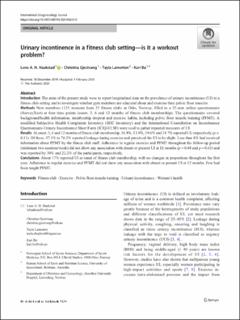| dc.contributor.author | Haakstad, Lene Annette Hagen | |
| dc.contributor.author | Gjestvang, Christina | |
| dc.contributor.author | Lamerton, Tayla | |
| dc.contributor.author | Bø, Kari | |
| dc.date.accessioned | 2020-07-10T06:35:37Z | |
| dc.date.available | 2020-07-10T06:35:37Z | |
| dc.date.created | 2020-04-28T10:08:46Z | |
| dc.date.issued | 2020 | |
| dc.identifier.citation | International Urogynecology Journal. 2020. | en_US |
| dc.identifier.issn | 0937-3462 | |
| dc.identifier.uri | https://hdl.handle.net/11250/2663634 | |
| dc.description | This article is licensed under a Creative Commons Attribution 4.0 International License, which permits use, sharing, adaptation, distribution and reproduction in any medium or format, as long as you give appropriate credit to the original author(s) and the source, provide a link to the Creative Commons licence, and indicate if changes were made. The images or other third party material in this article are included in the article's Creative Commons licence, unless indicated otherwise in a credit line to the material. If material is not included in the article's Creative Commons licence and your intended use is not permitted by statutory regulation or exceeds the permitted use, you will need to obtain permission directly from the copyright holder. To view a copy of this licence, visit http://creativecommons.org/licenses/by/4.0/. | en_US |
| dc.description.abstract | Introduction: The aims of the present study were to report longitudinal data on the prevalence of urinary incontinence (UI) in a fitness club setting and to investigate whether gym members are educated about and exercise their pelvic floor muscles. Methods: New members (125 women) from 25 fitness clubs in Oslo, Norway, filled in a 25-min online questionnaire (SurveyXact) at four time points (onset, 3, 6 and 12 months of fitness club membership). The questionnaire covered background/health information, membership dropout and exercise habits, including pelvic floor muscle training (PFMT). A modified Subjective Health Complaints Inventory (SHC Inventory) and the International Consultation on Incontinence Questionnaire-Urinary Incontinence Short Form (ICIQ-UI SF) were used to gather repeated measures of UI. Results: At onset, 3, 6 and 12 months of fitness club membership, 16.8%, 13.8%, 19.6% and 18.7% reported UI, respectively (p = 0.11). Of these, 57.1% to 76.2% reported leakage during exercise and perceived the UI to be slight. Less than 8% had received information about PFMT by the fitness club staff. Adherence to regular exercise and PFMT throughout the follow-up period (minimum two sessions/week) did not show any association with absent or present UI at 12 months (p = 0.48 and p = 0.63) and was reported by 30% and 22.2% of the participants, respectively. Conclusions: About 17% reported UI at onset of fitness club membership, with no changes in proportions throughout the first year. Adherence to regular exercise and PFMT did not show any association with absent or present UI at 12 months. Few had been taught PFMT. | en_US |
| dc.language.iso | eng | en_US |
| dc.subject | exercise | en_US |
| dc.subject | fitness club | en_US |
| dc.subject | pelvic floor muscle training | en_US |
| dc.subject | urinary incontinence | en_US |
| dc.subject | women’s health | en_US |
| dc.title | Urinary incontinence in a fitness club setting: Is it a workout problem? | en_US |
| dc.type | Peer reviewed | en_US |
| dc.type | Journal article | en_US |
| dc.description.version | publishedVersion | en_US |
| dc.rights.holder | The Author(s) 2020 | en_US |
| dc.source.pagenumber | 8 | en_US |
| dc.source.journal | International Urogynecology Journal | en_US |
| dc.identifier.doi | 10.1007/s00192-020-04253-0 | |
| dc.identifier.cristin | 1808395 | |
| dc.description.localcode | Institutt for idrettsmedisinske fag / Department of Sports Medicine | en_US |
| cristin.ispublished | true | |
| cristin.fulltext | original | |
| cristin.qualitycode | 1 | |
